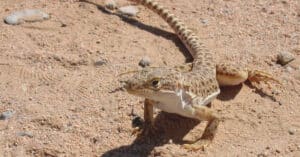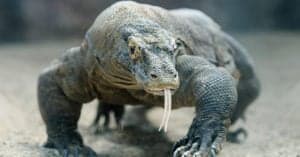Leopard Gecko Lifespan: How Long Do Leopard Geckos Live?
Adorable, low-maintenance, and friendly, leopard geckos are fascinating animals both as pets and in the wild. Notably, they are known as the very first species of lizard ever widely domesticated. Starting in the mid-1970s, these plucky little geckos were transported from their native habitats to homes all over the world and kept as pets. Ever since, many gecko owners and reptile enthusiasts alike have asked: how long do leopard geckos live?
Whether you are a proud leopard gecko owner, plan on adopting one, or are simply captivated by this unique species, it’s understandable that you’d want to know how long their lifespans are. Let’s take a look at how long you can expect a typical leopard gecko to live. We’ll also cover what factors influence their lifespans in the wild and in captivity.
How Long Do Wild Leopard Geckos Live?
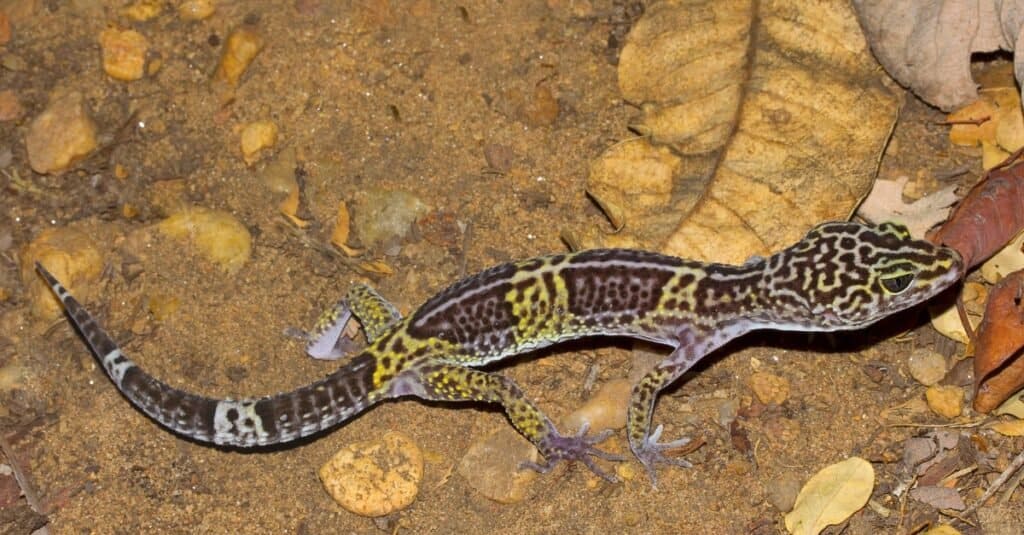
iStock.com/ePhotocorp
Leopard geckos are native to the dry, hot, mountainous deserts of the Middle East. More specifically, they reside in parts of Iran, India, Pakistan, and Afghanistan. Part of the reason why these lizards are so hardy and easy to care for in captivity is that they have evolved to handle harsh conditions in their native habitats very well.
Still, despite their robust, sturdy nature, a wild leopard gecko’s average lifespan is usually only around 3 to 8 years. Females tend to live slightly shorter lives than males. This is due to the physical and mental stressors involved with repeated breeding and egg-laying.
There are many reasons why wild geckos’ lifespans are so short, from the numerous predators they have to look out for to a variety of illnesses they are far more susceptible to when not closely monitored in captivity.
Factors Influencing Wild Leopard Geckos’ Lifespans
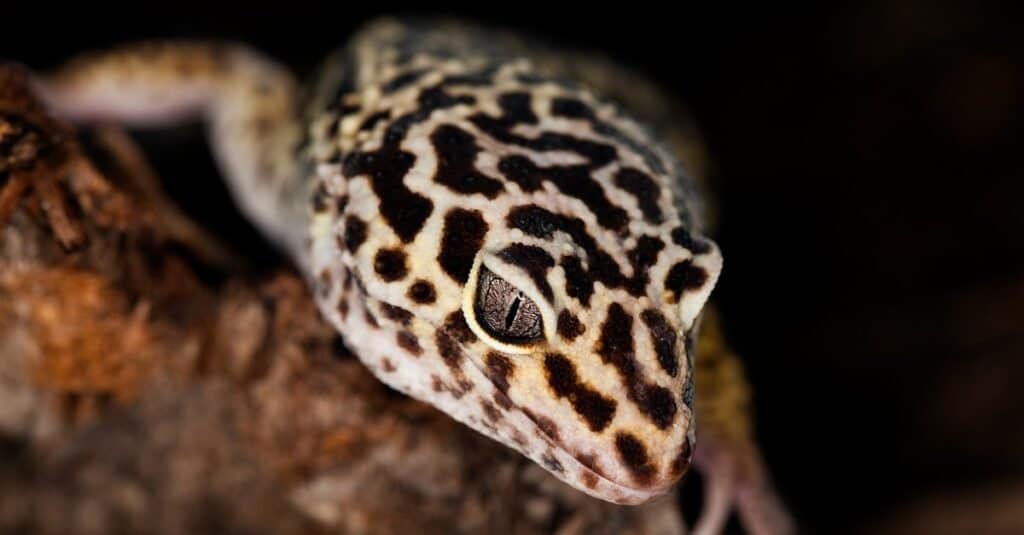
iStock.com/slowmotiongli
Wild leopard geckos have far shorter lifespans than their domesticated counterparts for a wide range of reasons. Here are the main factors that cause them to live only around half as long as captive geckos:
- Very high rate of predation by snakes, birds, spiders, and other larger carnivorous lizards
- Higher rate of parasites from eating wild insects (compared to captive geckos, who primarily eat insects that have been carefully bred in captivity)
- Illnesses and health conditions like malnutrition, impaction, dysecdysis (“stuck shed”), respiratory infections, eye issues, retained eggs, etc.
- No guaranteed means of acquiring treatment for the aforementioned health conditions
- Chronic stress from the above factors
Additionally, leopard geckos have only one reliable defense mechanism in the wild: tail dropping, also known as caudal autotomy. While it can prove effective as a one-time escape, it takes several weeks to re-grow the tail.
When their tail does grow back, it won’t be as large as the previous one. The gecko will also lose a significant fat store on their body in the meantime. Research shows that the process of autonomy even changes a leopard gecko’s posture and gait significantly!
When a leopard gecko drops their tail too often, they become stressed and weakened as a result. They can also sometimes drop their tails out of fear or sudden anxiety, even if they aren’t being actively chased by predators. Without the fat normally stored in their bulbous, chunky tails, leopard geckos can’t survive without food for very long.
How Long Do Pet Leopard Geckos Live?
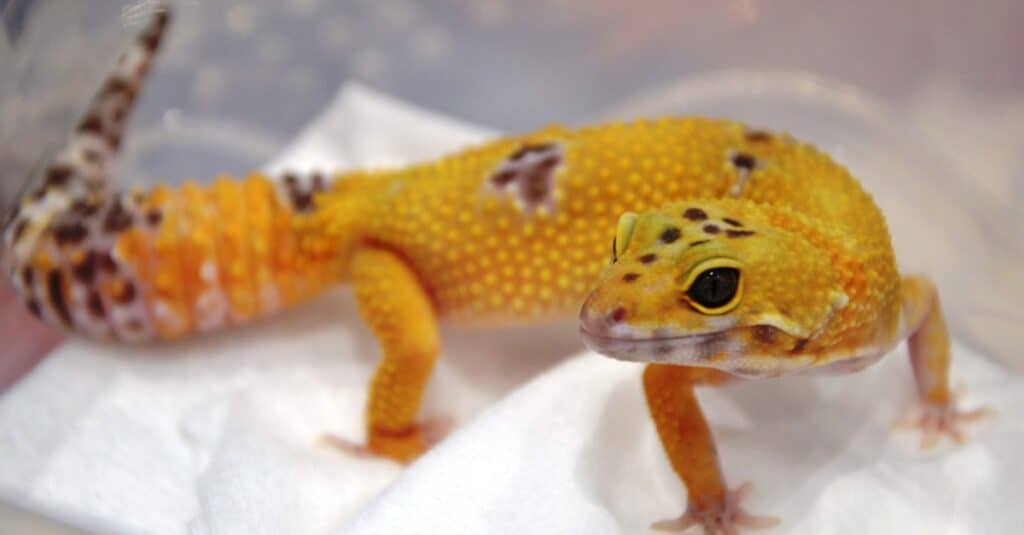
iStock.com/Vladimir Dyavhkov
Pet leopard geckos fare quite a bit better compared to wild leopard geckos. On average, they live for around 10 to 20 years. Captive females also tend to live slightly shorter lifespans than males, as they will often lay (infertile) eggs even if they haven’t been in contact with a male. This puts repeated stress on their bodies and shortens their lifespans as a result.
Incredibly, many captive geckos have lived well into their twenties; the longest-living leopard gecko, a male, allegedly lived a whopping 28 years in captivity! There are even a few rumors of an individual in Germany living for as long as 40 years.
However, extraordinary reports such as these are rare and largely unconfirmed. As we learn more about leopard gecko husbandry and properly caring for these unique lizards, their lifespans will hopefully continue to extend even further.
Factors Influencing Pet Leopard Geckos’ Lifespans
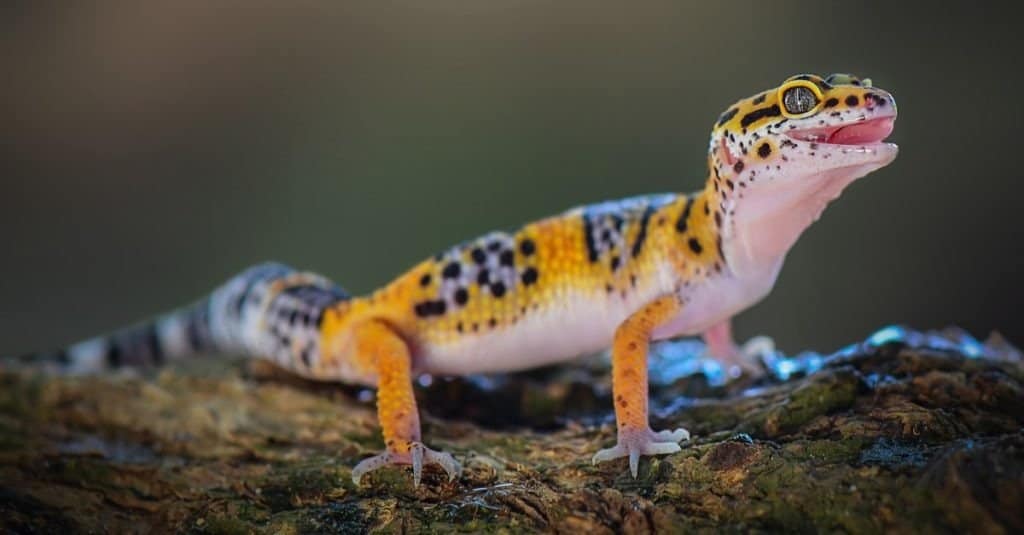
DWI YULIANTO/Shutterstock.com
When it comes to leopard geckos in captivity, there are many factors that influence their comparatively longer lifespans than wild geckos. These factors are:
- They have no predators to look out for, barring rare circumstances like cat or dog attacks
- Much lower rates of parasites; this is because they mostly eat insects that are born and raised in captivity and then sold to pet shops and other retailers
- Lower rates of illnesses and health conditions, mostly thanks to more sanitary and more closely regulated conditions
- Higher rates of effective, professional treatment if they do have certain illnesses or health conditions that would normally shorten their lifespan significantly
- Overall lower rates of stress compared to wild leopard geckos
Overall, the main reason why pet leopard geckos have longer lifespans is that they normally live in very strictly controlled enclosures. Ideally, temperature, humidity, and diet are all monitored closely and adjusted at the first sign of irregularities. If a gecko in captivity does become ill or injured, their owner usually has access to a local reptile veterinarian who can promptly treat them.
This, in turn, generally leads to happier and healthier geckos who live well into their teens rather than perishing much earlier from predators, starvation, or illness.
More from A-Z Animals
Adorable, low-maintenance, and friendly, leopard geckos are fascinating animals both as pets and in the wild. Notably, they are known as the very first species of lizard ever widely domesticated. Starting in the mid-1970s, these plucky little geckos were transported from their native habitats to homes all over the world and kept as pets. Ever since, many gecko owners and reptile enthusiasts alike have asked: how long do leopard geckos live?
Whether you are a proud leopard gecko owner, plan on adopting one, or are simply captivated by this unique species, it’s understandable that you’d want to know how long their lifespans are. Let’s take a look at how long you can expect a typical leopard gecko to live. We’ll also cover what factors influence their lifespans in the wild and in captivity.
How Long Do Wild Leopard Geckos Live?

iStock.com/ePhotocorp
Leopard geckos are native to the dry, hot, mountainous deserts of the Middle East. More specifically, they reside in parts of Iran, India, Pakistan, and Afghanistan. Part of the reason why these lizards are so hardy and easy to care for in captivity is that they have evolved to handle harsh conditions in their native habitats very well.
Still, despite their robust, sturdy nature, a wild leopard gecko’s average lifespan is usually only around 3 to 8 years. Females tend to live slightly shorter lives than males. This is due to the physical and mental stressors involved with repeated breeding and egg-laying.
There are many reasons why wild geckos’ lifespans are so short, from the numerous predators they have to look out for to a variety of illnesses they are far more susceptible to when not closely monitored in captivity.
Factors Influencing Wild Leopard Geckos’ Lifespans

iStock.com/slowmotiongli
Wild leopard geckos have far shorter lifespans than their domesticated counterparts for a wide range of reasons. Here are the main factors that cause them to live only around half as long as captive geckos:
- Very high rate of predation by snakes, birds, spiders, and other larger carnivorous lizards
- Higher rate of parasites from eating wild insects (compared to captive geckos, who primarily eat insects that have been carefully bred in captivity)
- Illnesses and health conditions like malnutrition, impaction, dysecdysis (“stuck shed”), respiratory infections, eye issues, retained eggs, etc.
- No guaranteed means of acquiring treatment for the aforementioned health conditions
- Chronic stress from the above factors
Additionally, leopard geckos have only one reliable defense mechanism in the wild: tail dropping, also known as caudal autotomy. While it can prove effective as a one-time escape, it takes several weeks to re-grow the tail.
When their tail does grow back, it won’t be as large as the previous one. The gecko will also lose a significant fat store on their body in the meantime. Research shows that the process of autonomy even changes a leopard gecko’s posture and gait significantly!
When a leopard gecko drops their tail too often, they become stressed and weakened as a result. They can also sometimes drop their tails out of fear or sudden anxiety, even if they aren’t being actively chased by predators. Without the fat normally stored in their bulbous, chunky tails, leopard geckos can’t survive without food for very long.
How Long Do Pet Leopard Geckos Live?

iStock.com/Vladimir Dyavhkov
Pet leopard geckos fare quite a bit better compared to wild leopard geckos. On average, they live for around 10 to 20 years. Captive females also tend to live slightly shorter lifespans than males, as they will often lay (infertile) eggs even if they haven’t been in contact with a male. This puts repeated stress on their bodies and shortens their lifespans as a result.
Incredibly, many captive geckos have lived well into their twenties; the longest-living leopard gecko, a male, allegedly lived a whopping 28 years in captivity! There are even a few rumors of an individual in Germany living for as long as 40 years.
However, extraordinary reports such as these are rare and largely unconfirmed. As we learn more about leopard gecko husbandry and properly caring for these unique lizards, their lifespans will hopefully continue to extend even further.
Factors Influencing Pet Leopard Geckos’ Lifespans

DWI YULIANTO/Shutterstock.com
When it comes to leopard geckos in captivity, there are many factors that influence their comparatively longer lifespans than wild geckos. These factors are:
- They have no predators to look out for, barring rare circumstances like cat or dog attacks
- Much lower rates of parasites; this is because they mostly eat insects that are born and raised in captivity and then sold to pet shops and other retailers
- Lower rates of illnesses and health conditions, mostly thanks to more sanitary and more closely regulated conditions
- Higher rates of effective, professional treatment if they do have certain illnesses or health conditions that would normally shorten their lifespan significantly
- Overall lower rates of stress compared to wild leopard geckos
Overall, the main reason why pet leopard geckos have longer lifespans is that they normally live in very strictly controlled enclosures. Ideally, temperature, humidity, and diet are all monitored closely and adjusted at the first sign of irregularities. If a gecko in captivity does become ill or injured, their owner usually has access to a local reptile veterinarian who can promptly treat them.
This, in turn, generally leads to happier and healthier geckos who live well into their teens rather than perishing much earlier from predators, starvation, or illness.




